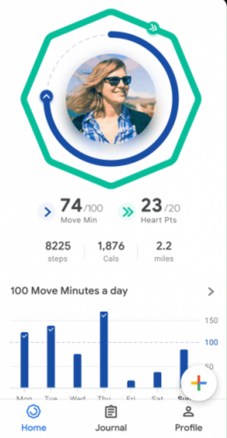Fullpower is a Santa Cruz, California-based privately held developer of cloud-based IoT and wearable product technology used for activity tracking and sleep monitoring. Fullpower specializes in wireless technology, microelectromechanical systems, and nanotechnology. The company holds over 125 patents for its intellectual property, which it licenses to manufacturers.
Fitbit is a line of wireless-enabled wearable technology, physical fitness monitors and activity trackers such as smartwatches, pedometers and monitors for heart rate, quality of sleep, and stairs climbed as well as related software. It operated as an American consumer electronics and fitness company from 2007 to 2021.
Withings is a French consumer electronics company headquartered in Issy-les-Moulineaux, France. It also has offices in Boston, Massachusetts, USA, and Hong Kong, and distributes its products worldwide. Withings is known for design and innovation in connected devices, such as the first Wi-Fi scale on the market, an FDA-cleared blood pressure monitor, a smart sleep system, and a line of automatic activity tracking watches. It also provides B2B services for healthcare providers and researchers.

A smartwatch is a portable wearable computer that resembles a wristwatch. Most modern smartwatches are operated via a touchscreen, and rely on mobile apps that run on a connected device in order to provide core functions.

Recon Instruments was a Canadian technology company that produced smartglasses and wearable displays marketed by the company as "heads-up displays" for sports. Recon's products delivered live activity metrics, GPS maps, and notifications directly to the user's eye. Recon's first heads-up display offering was released commercially in October 2010, roughly a year and a half before Google introduced Google Glass.
Runtastic GmbH is a digital health and fitness company from Austria.
Firebase was a company that developed backend software. It was founded in San Francisco in 2011 and was incorporated in Delaware.

Google Fit is a health-tracking platform developed by Google for the Android operating system, Wear OS, and iOS. It is a single set of APIs that blends data from multiple apps and devices. Google Fit uses sensors in a user's activity tracker or mobile device to record physical fitness activities, which are measured against the user's fitness goals to provide a comprehensive view of their fitness.

The Xiaomi Mi Band is a wearable activity tracker produced by Xiaomi, unveiled during a Xiaomi launch event on 22 July 2014. This article is mainly about the original Mi Band; later versions have separate articles.
Azumio is a mobile health company that specializes in biometric mobile technology. Founded in 2011, Azumio develops Apple iOS and Android health apps and services. Azumio has released 24 apps on iOS, 5 apps on Android, and 3 apps on Windows Phone. The company is headquartered in Palo Alto, California.

GOQii is an Indian fitness technology company, headquartered in California that offers a wearable fitness band with a mobile-app, and personalised remote health coaching. The company was founded by Vishal Gondal, the former CEO & Founder of Indiagames. After closing its beta Beta program in April 2014, GOQii became commercially available in India in August 2014. The company has offices in Mumbai, India and Shenzhen, China and plans to expand its services to the Middle East, the United States, and Singapore. Investors include Sumeru Ventures, Animoca Brands, Mitsui, NEA, Megadelta, DSG Consumer Partners, Galaxy Digital, Denlow Investment Trust, Edelweiss, Cheetah Mobile, GWC, Mr Ratan Tata, Mr Akshay Kumar and Mr Vijay Shekhar Sharma.

Microsoft Band is a discontinued smart band with smartwatch and activity tracker/fitness tracker features, created and developed by Microsoft. It was announced on October 29, 2014. The Microsoft Band incorporates fitness tracking and health-oriented capabilities and integrated with Windows Phone, iOS, and Android smartphones through a Bluetooth connection. On October 3, 2016, Microsoft stopped sales and development of the line of devices. On May 31, 2019, the Band's companion app was decommissioned, and Microsoft offered a refund for customers who were lifelong active platform users.
Hive is a trademark owned by Centrica Hive Limited that produces smart home devices. It is one of the largest connected home providers in the UK and, as of May 2018, the company had more than 1,000,000 customers.
A smart ring is a compact wearable electronic device that combines mobile technology with features for convenient on-the-go use. These devices, typically designed to fit on a finger like a traditional ring, offer functionalities like mobile payments, access control, gesture control, and activity tracking. Smart rings can connect to smartphones or other devices, and some can operate independently, communicating with cloud-based systems or performing standalone tasks. While lacking traditional displays, they respond to contextual cues, such as proximity to payment terminals or specific gestures.
Whistle Labs Inc. is a subsidiary of Mars Petcare headquartered in San Francisco, California. It produces and markets the Whistle GPS Pet Tracker, a device worn on a pet's collar that monitors its activity and location. In addition to pet owners, the devices have been used by veterinary researchers.
Bellabeat is a wellness company founded by Urška Sršen and Sandro Mur in 2014. It is best known for its Leaf smart jewelry wearable line. The company has offices in San Francisco, Zagreb and Hong Kong. In 2023, the company had a revenue of US$650 million, according to its investor Nordic Eye.
Beddit Oy is a Finnish technology company that sells sleep tracking devices and a sleep tracking application to help monitor sleep. The company was founded in October 2006 and released their first sleep tracker in November 2013. In May 2017, Beddit was acquired by Apple Inc.

Amazfit is a Chinese smart wearable brand, established in September 2015 and headquartered in Hefei, Anhui Province. Its products are manufactured and owned by Zepp Health. The brand offers wearable devices including smartwatches, fitness bands,smart ring and equipment related to health and sports.
Oura Health Ltd is a Finnish health technology company, known for the Oura Ring, a smart ring used to track sleep and physical activity. The company was founded in 2013 by Petteri Lahtela, Kari Kivelä, and Markku Koskela. Harpreet Singh Rai was the CEO from 2018 until 2021, when he was replaced on an interim basis by Michael Chapp. In 2022, Tom Hale was appointed CEO. The company is headquartered in Oulu, Finland, with other locations in Helsinki, Finland, and San Francisco, United States. The company raised its initial US$2.3 million seed funding in 2015 led by Lifeline Ventures, introduced the first-generation ring via Kickstarter in 2016 and launched the ring at the Slush tech conference in 2017.








